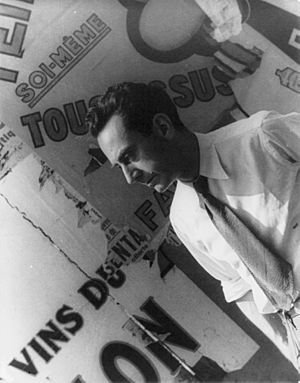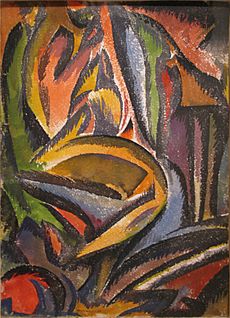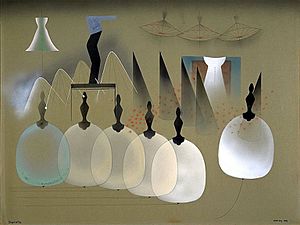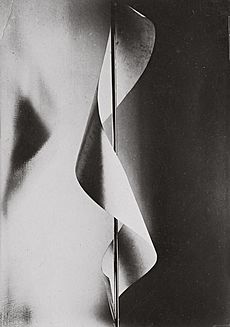Man Ray facts for kids
Quick facts for kids
Man Ray
|
|
|---|---|

Man Ray, photographed in Paris by Carl Van Vechten in 1934
|
|
| Born |
Emmanuel Radnitzky
August 27, 1890 Philadelphia, Pennsylvania, U.S.
|
| Died | November 18, 1976 (aged 86) Paris, France
|
| Known for | Painting, photography, assemblage, collage, film |
| Movement | Dada, surrealism |
| Spouse(s) |
Adon Lacroix
(m. 1914; div. 1937)Juliet Browner
(m. 1946) |
| Partner(s) | Lee Miller (1929–1932) |
Man Ray (born Emmanuel Radnitzky; August 27, 1890 – November 18, 1976) was an American artist. He spent most of his life working in Paris, France. Man Ray was a very important part of the Dada and Surrealist art movements.
He created amazing art using many different types of materials. Even though he worked in many fields, he thought of himself as a painter first. He was famous for his new ideas in photography. He was also a well-known fashion and portrait photographer. Man Ray was also known for his "rayographs," which were special photos made without a camera.
Contents
Man Ray's Life Story
His Early Years and Family
Man Ray didn't share much about his early life. He even preferred to be known only as Man Ray.
He was born Emmanuel Radnitzky in South Philadelphia, Pennsylvania. This was on August 27, 1890. He was the oldest of four children. His parents were Russian Jewish immigrants. His father, Melach "Max" Radnitzky, was a tailor. His mother, Manya "Minnie" Radnitzky, designed clothes.
In 1912, his family changed their last name to Ray. They did this because of the ethnic unfairness they faced. Emmanuel, who was called "Manny," changed his first name to Man. Soon, he started using Man Ray as his full name.
Man Ray's father had a tailoring business at home. His children helped him from a young age. His mother enjoyed making clothes and patchwork items. Even though Man Ray wanted to be different from his family's background, tailoring influenced his art. You can see things like mannequins, irons, and sewing machines in his artworks. Art experts have noticed how his art techniques were like tailoring.
Man Ray was the uncle of photographer Naomi Savage. She learned some of his special art methods.
Starting His Art Journey
Man Ray showed talent in art and mechanics when he was a child. He went to Boys' High School in Brooklyn from 1904 to 1909. There, he learned important art skills like drafting. He also visited art museums often to study famous artworks.
After high school, he was offered a scholarship to study architecture. But he chose to become an artist instead. His parents were not happy with his choice. Still, they let him use his room as an art studio. For the next four years, he worked hard to become a professional painter. He also earned money as a commercial and technical illustrator.
At first, his art looked like 19th-century styles. But he loved new, modern art he saw at galleries. In 1912, he joined the Ferrer School. This started a time of fast artistic growth for him.
Life in New York City
In New York City, Man Ray was inspired by new European art. He saw this art at the 1913 Armory Show and at Alfred Stieglitz's "291" art gallery. His early paintings showed parts of cubism, an art style. Later, he became friends with Marcel Duchamp. Duchamp was interested in showing movement in art. Man Ray's paintings then started to show movement, like the dancer's skirts in The Rope Dancer Accompanies Herself with Her Shadows (1916).
In 1915, Man Ray had his first art show. He had moved to an art colony in Grantwood, New Jersey. In 1916, he showed his first Dada art object called Self-Portrait. He started taking photos in 1918 to record his own artwork.
Man Ray stopped traditional painting to join Dada. Dada was a new art movement that went against old art rules. He made two Dada magazines, but each only had one issue. He also started making art objects. He found new ways to make images using machines and photography. For example, he used a spray-gun for his 1918 Rope Dancer.
Like Duchamp, he used "readymades." These were everyday objects he chose and changed into art. His Gift (1921) was an flatiron with metal tacks on it. Enigma of Isidore Ducasse was a sewing machine wrapped in cloth.
In 1920, Man Ray helped Duchamp create Rotary Glass Plates. This was an early example of kinetic art, which is art that moves. That same year, Man Ray, Katherine Dreier, and Duchamp started the Société Anonyme. This was the first museum for modern art in the U.S.
Man Ray felt that New York City itself was like Dada. He wrote that "Dada cannot live in New York. All New York is dada."
In 1913, Man Ray met Adon Lacroix, a Belgian poet. They married in 1914.
Moving to Paris
In July 1921, Man Ray moved to Paris, France. He settled in the Montparnasse area, where many artists lived. There, he accidentally rediscovered a way to make photos without a camera. He called these "rayographs." These mysterious images were praised as "pure Dada creations."
Soon after arriving in Paris, he met Kiki de Montparnasse. She was an artist's model and a well-known person in Paris art circles. Kiki was Man Ray's partner for much of the 1920s. She became the subject of many of his famous photos. She also starred in his experimental films Le Retour à la Raison and L'Étoile de mer.
In 1929, he began a relationship with Surrealist photographer Lee Miller. She was also his photographic assistant. Together, they rediscovered a photo technique called solarization. Miller left him in 1932.
From 1934 to 1940, Man Ray was in a relationship with Adrienne Fidelin. She was a dancer and model from Guadeloupe. She appeared in many of his photographs.
Man Ray was a leading photographer in Paris for 20 years. Many important artists and writers posed for his camera. These included Pablo Picasso, James Joyce, and Salvador Dalí. His fame grew with photos of the Maharajah Yashwant Rao Holkar II and his wife.
He also photographed African art objects. This led to famous photos like Noire et blanche. Experts say Man Ray was very important in showing African art through modern photography.
Man Ray's art was shown in the first Surrealist exhibition in Paris in 1925. Other artists in the show included Jean Arp and Joan Miró. Important works from this time include Object to Be Destroyed, a metronome with an eye. Another famous work is Violon d'Ingres, a stunning photo of Kiki de Montparnasse. This photo showed how Man Ray could put different things together to create new meaning.
Man Ray also directed several important avant-garde short films. These were known as Cinéma Pur. He directed Le Retour à la Raison (1923), Emak-Bakia (1926), L'Étoile de Mer (1928), and Les Mystères du Château de Dé (1929). He also helped Marcel Duchamp with his film Anemic Cinema (1926). Man Ray filmed Fernand Léger's Ballet Mécanique (1924). In the film Entr'acte (1924), Man Ray played chess with Duchamp. These artists were friends and worked together on many creative projects.
Time in Hollywood
The Second World War made Man Ray return to the United States. He lived in Los Angeles from 1940 to 1951. During this time, he focused on painting. Soon after arriving, he met Juliet Browner. She was a dancer and an artist's model. They married in 1946. In 1948, Man Ray had an art show in Beverly Hills. It featured many of his works, including new paintings.
Later Life and Legacy
Man Ray went back to Paris in 1951. He and Juliet settled into a studio near the Luxembourg Gardens. He continued to create art in many forms. In his later years, he remade some of his famous early works. He also made limited copies of his art objects.
In 1963, he published his life story, called Self-Portrait.
Man Ray kept working on new paintings, photos, and art objects until he died. He passed away from a lung infection in Paris on November 18, 1976. He was buried in the Cimetière du Montparnasse in Paris. His tombstone says, "Unconcerned, but not indifferent." When Juliet died in 1991, she was buried next to him. Her tombstone says, "Together again." Juliet created a trust to protect Man Ray's art. She gave many of his works to museums.
Man Ray's New Ideas
Man Ray created many new ideas in modern art, film, and photography. He used photograms to make surreal images he called "Rayograms." He also rediscovered solarization with Lee Miller. His 1923 film Le Retour à la raison was the first "cine-rayograph." This was a movie made without a camera. Man Ray's 1935 Space Writing (Self-Portrait) was the first light painting. This was 14 years before Picasso's light paintings.
Awards and Recognition
In 1974, Man Ray received the Royal Photographic Society's Progress Medal. This was for his important contributions to photography. In 1999, ARTnews magazine named Man Ray one of the 25 most important artists of the 20th century. They praised his amazing photography and his work in film, painting, and sculpture. They also noted his early ideas for what would become performance art and conceptual art.
Art Sales Records
Man Ray's Le Violon d'Ingres (1924) is a famous photograph. It shows Kiki de Montparnasse's back with violin f-holes on it. This photo sold for $12.4 million in May 2022. This set a new world record for the most expensive photograph ever sold at auction.
In 2017, Man Ray's Noire et Blanche (1926) sold for over $3.1 million. This was a record for his photographic work at the time. It was also the most expensive vintage photograph ever sold at auction then.
Two other works by Man Ray have sold for more. His 1916 painting Promenade sold for $5.8 million in 2013. His art object Catherine Barometer (1920) sold for over $3.2 million in 2017. These sales show how valuable and important Man Ray's art is.
Images for kids
-
Man Ray, 1920, Three Heads (showing Joseph Stella and Marcel Duchamp).
-
Salvador Dalí and Man Ray in Paris, 1934.
See also
 In Spanish: Man Ray para niños
In Spanish: Man Ray para niños
- The Gift, a sculpture from 1921











